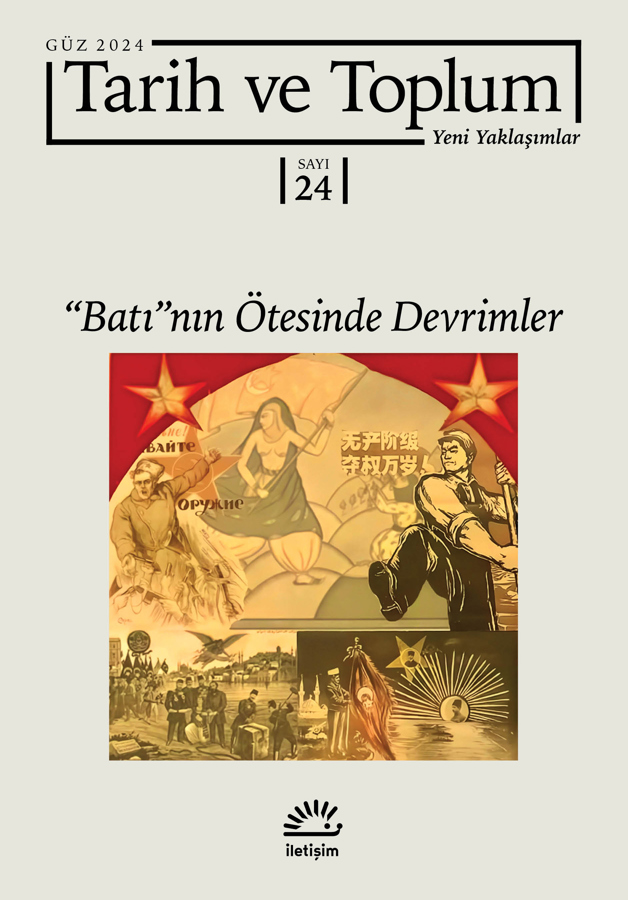The 1911 Revolution in China and the role of the local elite
HALE EROĞLU
This paper examines the key agents behind the 1911 Revolution in China, which overthrew the Qing dynasty and established a republic. While mainstream historiography has emphasized the role of anti-Manchu revolutionaries, this article argues that the revolution would not have been possible without the participation of institutions created during the New Qing reforms of the early 1900s, such as provincial assemblies, the New Army, and Chambers of Commerce. The article highlights the critical role played by the reformist elite, who initially sought to preserve the Qing Empire by transforming it into a constitutional monarchy. However, the divide between reformists and revolutionaries narrowed during the “railroad rights recovery movement.” The imperial court’s decision to nationalize the railroads, thereby enhancing its centralizing power, conflicted with the local interests of reformist elites, intensifying tensions. As a result, the revolution emerged as the culmination of the conflict between centralizing and decentralizing forces in Chinese history and was made possible under the conditions shaped by the ideological mobilization of the revolutionaries and the peasant uprisings that erupted in many parts of China.
Nonetheless, the Republican Revolution failed to achieve its objectives, and China soon entered a period of fragmentation. It was only with the Communist Revolution in 1949 that China was reunified under a centralized regime.
Keywords: China, Sun Yatsen, reformist elite, anti-Manchu revolutinaries, Railroad Rights Recovery Movement
*
Armenian women’s transimperial connections and revolutionary activism in Iran
HOURI BERBERIAN
The article examines the revolutionary and social mobilization of Armenian women, shaped by trans-imperial connections across Iran, the Ottoman Empire, and Tsarist Russia from the late 19th century onward. Figures like Satenik Matinyan played pivotal roles in disseminating revolutionary ideas and promoting women’s activism across these borders, notably contributing to the establishment of the Armenian Women’s Benevolent Society in Tabriz. Women’s organizations in cultural hubs such as Istanbul, Tbilisi, and Tabriz focused on expanding education and social solidarity, particularly by supporting girls’ education. These organizations spearheaded women’s rights movements, fostering the spread of revolutionary ideas and cooperation while advancing women’s access to education and social awareness. However, these processes have often been overshadowed by nationalist historiography, which has failed to adequately recognize the significant roles women played in these movements.
Keywords: Armenian women’s movement, women organizations, revolutionary movement in Caucasia, women rights and education
*
Jalil Mamedqolizādeh, pioneering Azerbaijani Journalist
JANET AFARY - KAMRAN AFARY
The article explores the life and contributions of Jalil Mammadguluzadeh (Mirza Jalil), a pioneering Azerbaijani journalist, writer, and founder of the satirical magazine Molla Nasreddin. Established in 1906 in Tbilisi, the magazine became a groundbreaking platform for social critique, addressing issues like colonialism, religious hypocrisy, gender inequality, and oppressive cultural practices across Transcaucasia, Iran, and the Ottoman Empire. Known for its inclusive and collaborative team of writers, artists, and editors from diverse religious and social backgrounds, Molla Nasreddin used humor and satire to promote social change and challenge authoritarianism. Despite facing censorship, persecution, and political threats, Mammadguluzadeh and his colleagues advanced ideas of equality, education, and resistance to colonial and patriarchal structures. His works and the magazine’s legacy continue to symbolize progressive thought and cultural reform in the region.
Keywords: Mirza Jalil, satire and journalism in Transcaucasia, Molla Nasreddin, cultural reform
*
Qaimaqam Sırrı Bey’s weird story and the restraint of violence in early 20th century Ottoman society: “Don’t let Adapazarı become Adana!”
ÜMİT KURT
In the last decade, historiography has amply documented violent events in the Ottoman Empire in the late 19th and early 20th centuries. Indeed, we have reached a point where the absence of violence is less often taken into account. This article offers an examination of the absence of violence. It begins with a story of prostitution in a bathhouse in Adapazarı in 1911. The article focuses on an incident that could easily have turned into riots and massacres in otherm contexts of the period. Based on this incident in a bathhouse in Northwestern Anatolia, it shows how the social will for coexistence prevailed despite the relentless efforts and interventions of an Ottoman statesman. This article aims to make an important contribution to the analysis of social relations in the late Ottoman Empire and the modern Middle East. It also reveals how important regional differences were in curbing inter-communal violence in the late empire.
Key words: violence, restraint of violence, Adapazarı, Union and Progress, Sırrı Bey, prostitution, Islam, constitutional regime, constitution, Muslim and Christian communities
*
Chasing a phantom class: Ankara’s Muslim-Turkish bourgeoisie from the late Ottoman Empire to the early Republic
ALPER KAYA
This article examines the evolution and relationship with the state of Ankara’s Muslim-Turkish bourgeoisie from the Tanzimat period through the early years of the Turkish Republic. The vested narrative of Ottoman and Turkish historiographies claims that the Muslim-Turkish bourgeois class developed rather late compared to that in Europe and even waited for state intervention to emerge. Contrary to general belief, this article focuses on the class dynamics of Ankara’s Muslim-Turkish bourgeoisie by tracing its roots to the Ottoman period. Focusing on specific families, this study points to continuity from the
Tanzimat era to the Republic. By examining the family origins, commercial ties, roles in local councils, and class reflexes of many prominent political and economic figures from Ankara –especially in the first decade of the Republic– this research demonstrates that the foundations of this class were laid well before national economic policies were introduced. By covering the Second Constitutional Period, the National Struggle, and the Republic, it argues that this class successfully adapted to each new era and condition, prioritizing its class interests throughout.
Keywords: bourgeoisie, national bourgeoisie, merchant, Ankara, Muslim-Turk, economic history of the Turkish Republic

